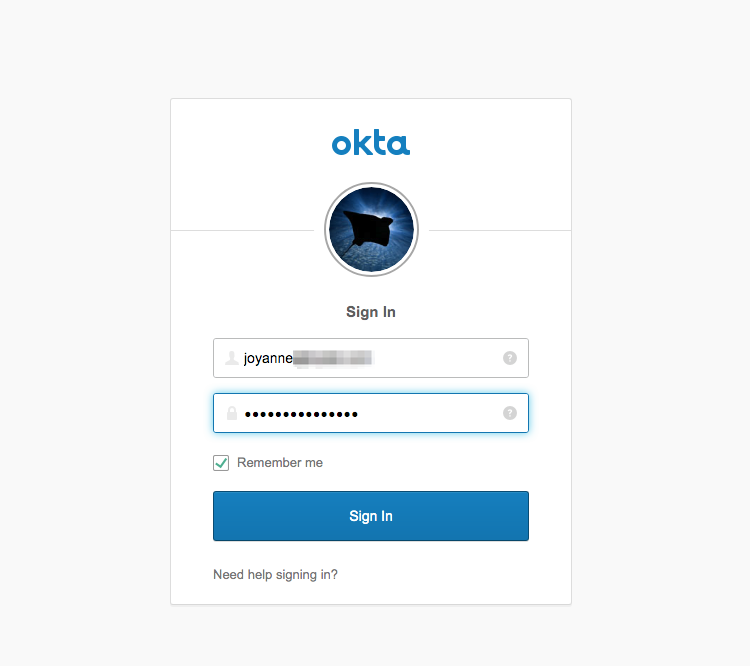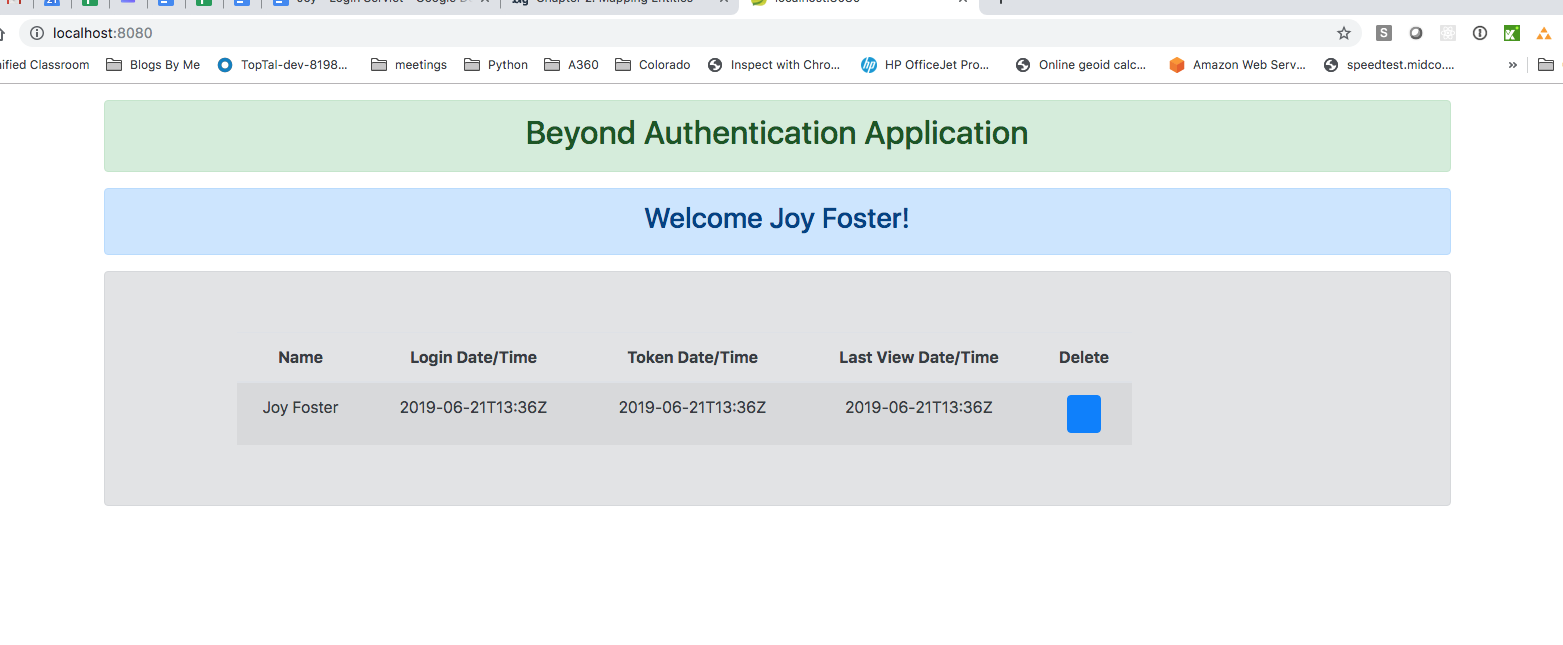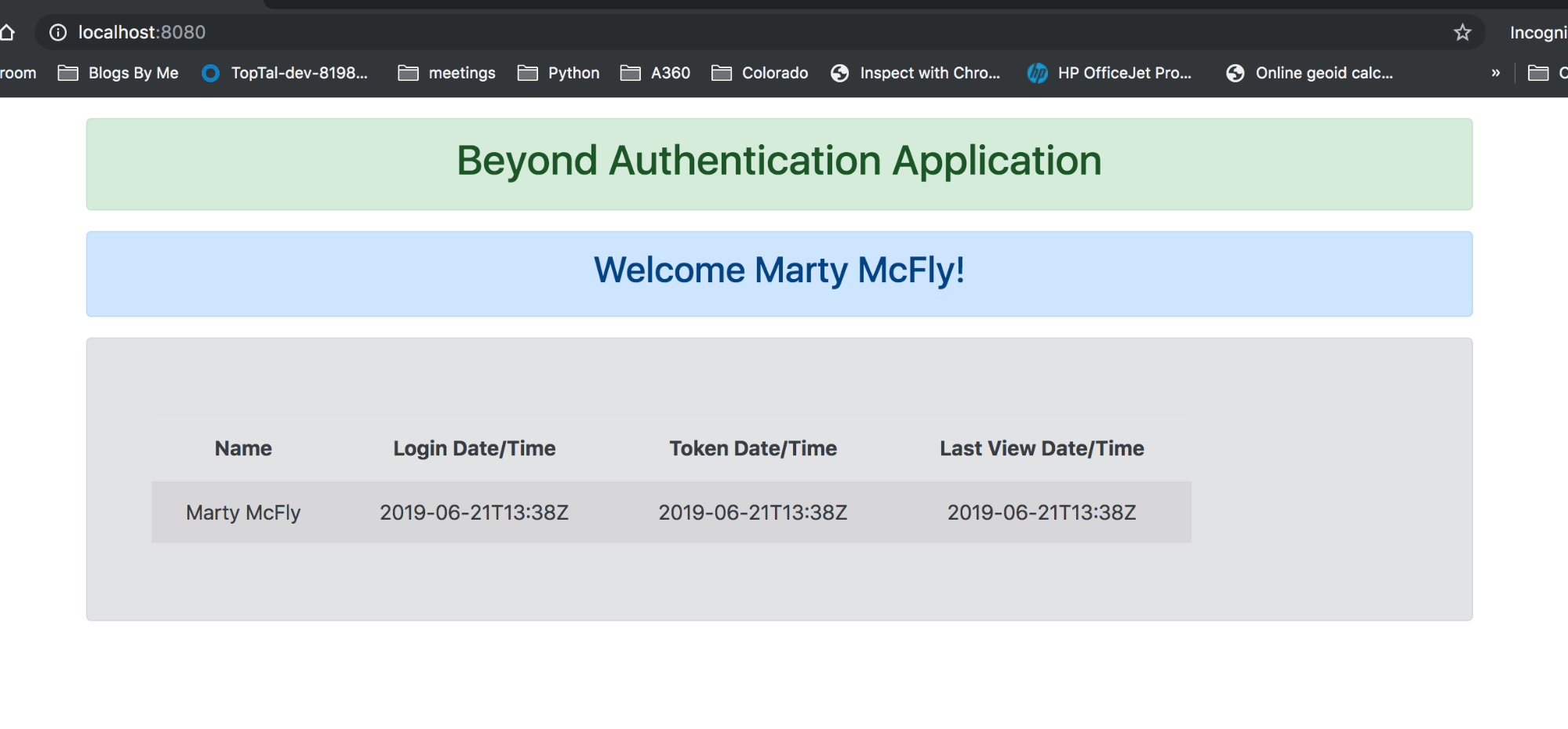Use Spring Boot and MySQL to go Beyond Authentication

In this post, we will walk through how to build a simple CRUD application using Spring Boot, MySQL, JPA/Hibernate and Okta OpenID Connect (OIDC) Single Sign-On (SSO).
The Java Persistence API (JPA) provides a specification for persisting, reading, and managing data from your Java object to relational tables in the database. The default implementation of JPA via Spring Boot is Hibernate. Hibernate saves you a lot of time writing code to persist data to a database, allowing you to focus on the business logic.
In this example, we will use MySQL for the database.
The application you will build will have two main parts. The first is the authentication piece. This will use Okta OIDC SSO to authenticate admin or ordinary users into the application. The second part will be the management of user events. These events are a record of any time a new token is issued for this application. The event will store the user’s name, internal id from Okta, and store additional information per token issuance including the time of the original login and the time the token was last used within the application to view a page. If you are wondering what the difference is between these three dates/times, here is a cheat-sheet:
- Login Date/Time - This is the time at which the user actually had to enter their credentials. There can be more than one token issued against the same original login. This could be the time the user logged into this application, the Okta console, or another application tied to the same developer account (since this is an SSO example).
- Token Date/Time - When the user starts a session with the application described in this post, a new token is issued by Okta. This token is valid for a certain amount of time and is reused across page refreshes until it expires
- Last View Date/Time - This is the last time the application was viewed. If you refresh the page, this time will update, while the Token Date/Time and Login Date/Time should remain the same.
Table of Contents
- Summary of CRUD actions
- Configure your Okta OIDC Application, Authorization Server, Groups, and Users
- Let’s code it!
- Let’s Run it!
- Further Reading
Note: In May 2025, the Okta Integrator Free Plan replaced Okta Developer Edition Accounts, and the Okta CLI was deprecated.
We preserved this post for reference, but the instructions no longer work exactly as written. Replace the Okta CLI commands by manually configuring Okta following the instructions in our Developer Documentation.
Summary of CRUD actions
CRUD - Create
When any user visits the application with a new session, they will be issued a new token. When this token is issued, a userEvent will be generated and persisted in the MySQL database.
CRUD - Read Ordinary users will be able to see a list of all of the times they have received a new Okta token for this application. The application will also display the Login Date/Time and Last View Date/Time for that token (described earlier).
Admin users will be able to see the same info as the normal user, but for all users who have logged into the system.
CRUD - Update
Each time any user visits the application, it will check if the token that they are using has already been saved as a userEvent. If so, it will update that entry with a new Last View Date/Time
CRUD - Delete
Admin users will have the option to delete any of the user events in the system.
Pro Tip: In a production system, you wouldn’t want to ever delete a log history, particularly a log regarding authentication or authorization actions. If this were production code and you had a requirement to delete log entries in order to hide them from ordinary users, you would likely want to implement this by setting a deleted flag on that record and only displaying records that are not flagged as deleted.
Prerequisites:
- Java 11+ - You can install it from adoptopenjdk.net.
- MySQL - You must have installed a local instance of MySQL or have access to a remote instance of MySQL. For this exercise, I recommend that you have a fresh empty database prepared and have the username and password for that database handy. They will be required in the
application.propertiesfile later. If you don’t have MySQL setup locally already, follow the instructions from the MySQL Website.
Configure your Okta OIDC Application, Authorization Server, Groups, and Users
Before you dive into the code, you will want to first get your Okta configuration in place.
Set Up Your Okta OIDC Application
Before you begin, you’ll need a free Okta developer account. Install the Okta CLI and run okta register to sign up for a new account. If you already have an account, run okta login.
Then, run okta apps create. Select the default app name, or change it as you see fit.
Choose Web and press Enter.
Select Other.
Then, change the Redirect URI to http://localhost:8080/login/oauth2/code/okta and use http://localhost:8080 for the Logout Redirect URI.
What does the Okta CLI do?
The Okta CLI will create an OIDC Web App in your Okta Org. It will add the redirect URIs you specified and grant access to the Everyone group. You will see output like the following when it’s finished:
Okta application configuration has been written to: /path/to/app/.okta.env
Run cat .okta.env (or type .okta.env on Windows) to see the issuer and credentials for your app.
export OKTA_OAUTH2_ISSUER="https://dev-133337.okta.com/oauth2/default"
export OKTA_OAUTH2_CLIENT_ID="0oab8eb55Kb9jdMIr5d6"
export OKTA_OAUTH2_CLIENT_SECRET="NEVER-SHOW-SECRETS"
Your Okta domain is the first part of your issuer, before /oauth2/default.
NOTE: You can also use the Okta Admin Console to create your app. See Create a Web App for more information.
Take note of the values in the generated .okta.env file. You’ll use those values shortly.
Add an Okta Authorization Server
Next, you’ll set up an Authorization Server with custom claims and access policies. This drives whether or not Okta will issue a token when one is requested. Run okta login and open the returned URL in your browser. Sign in and go to Security > API > Authorization Servers. Click Add Authorization Server. Fill in the values as follows:
| Field | Value |
|---|---|
| Name | Beyond Authentication Application |
| Audience | api://beyondauthenticationapplication |
| Description | Beyond Authentication Application |
Click Create. Click the Claims tab. Click Add Claim. Fill in the fields with these values and click Create (leave those not mentioned as their defaults):
| Field | Value |
|---|---|
| Name | appName |
| Include in token type | ID Token Always |
| Value | “Beyond Authentication Application” |
Note that there are double quotes (“) around “Beyond Authentication Application”.
Next, click on Add Claim again. Fill in the fields with these values and click Create (leave those not mentioned as their defaults):
| Field | Value |
|---|---|
| Name | groups |
| Include in token type | ID Token Always |
| Value Type | Groups |
| Filter Dropdown | Matches regex |
| Filter Value | .* |
Click the Access Policies tab. Click Add Policy. Fill in the fields with these values and click Create Policy.
| Field | Value |
|---|---|
| Name | Beyond Authentication Application |
| Description | Beyond Authentication Application |
| Assign to | The following clients |
| Assign to clients | Start typing: Beyond in the input area below The following clients and click Add to the right of Beyond Authentication Application. |
This binds the policy to your OIDC app.
Next click Add Rule. Enter: Beyond Authentication Application for the Rule Name field. Deselect all the grant types except for Authorization Code. Click Create Rule. This ensures that the request must use the Authorization Code flow in order for Okta to create tokens. This is the most secure flow of all the available OAuth flows. It ensures that all sensitive information (like tokens) are delivered via a response to a POST request. Check out the references at the end of this post for more on OAuth flows.
Click the Settings tab and copy the Issuer URL. You’ll make use of this value shortly.
Create an Okta Admin Group for Your Spring Boot Application
In order to complete this application, we need to set up an “Admin” group for our application. To do this, within the Okta Admin Console, click on Directory > Groups and then click on Add Group. Enter the following values:
| Field | Value |
|---|---|
| Name | Admin |
| Description | Admin Group |
Create Okta Users for Your Application
Finally, we need to create two users. The first will be an ordinary user and the second will be an admin user. Click on Directory > People and then click on Add Person. Fill out the form with the information for the ordinary (non-admin) user using the table below. Repeat this for the Admin user, also using the table below.
| Ordinary User | Admin User | Comments | |
|---|---|---|---|
| First Name | Plain | Super | Can be anything you like |
| Last Name | Jane | Admin | Can be anything you like |
| Username | plainJane@something.com | superAdmin@something.com | Might prefer to test with an email you can actually access |
| Primary Email | plainJane@something.com | superAdmin@something.com | |
| Secondary Email | |||
| Groups | Admin | ||
| Password | Set by Admin | Set by Admin | This is to simplify the demo. In a production environment, you will likely want this set to “set by user” |
| Password Value | Test1234 | Test1234 | Complexity requirements: - at least 8 characters - a lowercase letter - an uppercase letter - a number - no parts of your username |
| User must change password | unchecked | unchecked | This is to simplify the demo. In a production environment, you will likely want this checked if you have admin set password. |
Take note of the username and password for each of the two users you created as you will use them to login later on.
Let’s code it!
The structure of our project will look like this:

NOTE: For this post, I will be using Eclipse, as it is my preferred IDE. However, you can use any IDE or editor you please.
Dependencies
The Spring Initializr makes it super easy to create the scaffolding for your project. What’s even better is that it has a RESTful API, so you can get everything setup right from the command line. Run this command:
curl -s https://start.spring.io/starter.zip \
-d dependencies=data-jpa,web,okta,thymeleaf,mysql \
-d packageName=com.okta.examples.jpa \
-d groupId=com.okta.examples.jpa \
-d name=BeyondAuthentication \
> BeyondAuthentication.zip
Create a folder named: BeyondAuthentication, switch into it and unzip the resulting file. You’ll see the whole project has been setup for you. Let’s take a look at the pom.xml file, which has all the dependencies for the project.
The file should be set up as follows
<?xml version="1.0" encoding="UTF-8"?>
<project xmlns="http://maven.apache.org/POM/4.0.0" xmlns:xsi="http://www.w3.org/2001/XMLSchema-instance"
xsi:schemaLocation="http://maven.apache.org/POM/4.0.0 http://maven.apache.org/xsd/maven-4.0.0.xsd">
<modelVersion>4.0.0</modelVersion>
<parent>
<groupId>org.springframework.boot</groupId>
<artifactId>spring-boot-starter-parent</artifactId>
<version>2.4.5</version>
<relativePath/> <!-- lookup parent from repository -->
</parent>
<groupId>com.okta.examples.jpa</groupId>
<artifactId>demo</artifactId>
<version>0.0.1-SNAPSHOT</version>
<name>BeyondAuthentication</name>
<description>Demo project for Spring Boot</description>
<properties>
<java.version>11</java.version>
</properties>
<dependencies>
<dependency>
<groupId>org.springframework.boot</groupId>
<artifactId>spring-boot-starter-data-jpa</artifactId>
</dependency>
<dependency>
<groupId>org.springframework.boot</groupId>
<artifactId>spring-boot-starter-thymeleaf</artifactId>
</dependency>
<dependency>
<groupId>org.springframework.boot</groupId>
<artifactId>spring-boot-starter-web</artifactId>
</dependency>
<dependency>
<groupId>com.okta.spring</groupId>
<artifactId>okta-spring-boot-starter</artifactId>
<version>2.0.1</version>
</dependency>
<dependency>
<groupId>mysql</groupId>
<artifactId>mysql-connector-java</artifactId>
<scope>runtime</scope>
</dependency>
<dependency>
<groupId>org.springframework.boot</groupId>
<artifactId>spring-boot-starter-test</artifactId>
<scope>test</scope>
</dependency>
</dependencies>
<build>
<plugins>
<plugin>
<groupId>org.springframework.boot</groupId>
<artifactId>spring-boot-maven-plugin</artifactId>
</plugin>
</plugins>
</build>
</project>
The dependencies above tell the system that you want to use Thymeleaf for your web templates, MySQL for your database, and Hibernate (the default JPA implementation) to persist and retrieve data from MySQL.
Templates
Let’s also knock out the HTML template now, so you will have an idea what the application is trying to do/show later. Create the home.html file in the src/main/resources/templates folder.
<!doctype html>
<html lang="en" xmlns:th="http://www.thymeleaf.org">
<head>
<link rel="stylesheet" href="https://stackpath.bootstrapcdn.com/bootstrap/4.1.3/css/bootstrap.min.css" integrity="sha384-MCw98/SFnGE8fJT3GXwEOngsV7Zt27NXFoaoApmYm81iuXoPkFOJwJ8ERdknLPMO" crossorigin="anonymous">
</head>
<body>
<div class="container-fluid">
<div class="row justify-content-md-center">
<div class="w-75">
<p/>
<div th:if="${user.claims.containsKey('appName')}"
class="alert alert-success text-center" role="alert"
>
<h2 th:text="${user.claims.appName}"></h2>
</div>
<p/>
<div th:if="${user.claims.containsKey('name')}"
class="alert alert-primary text-center" role="alert"
>
<h3 th:inline="text">Welcome [[${user.claims.name}]]!</h3>
</div>
<div class="alert alert-secondary text-center">
<div th:switch="${userEvents}" class="container my-5">
<div class="col-md-10">
<h2 th:case="null">No User Events yet!</h2>
<div th:case="*">
<table class="table table-striped table-responsive-md">
<thead>
<tr>
<th>Name</th>
<th>Login Date/Time</th>
<th>Token Date/Time</th>
<th>Last View Date/Time</th>
<th th:if="${isAdmin}">Delete</th>
</tr>
</thead>
<tbody>
<tr th:each="userEvent : ${userEvents}">
<td th:text="${userEvent.name}"></td>
<td th:text="${userEvent.loginAtString}"></td>
<td th:text="${userEvent.tokenIssuedAtString}"></td>
<td th:text="${userEvent.lastViewedAtString}"></td>
<td th:if="${isAdmin}"><a th:href="@{/delete/{id}(id=${userEvent.id})}" class="btn btn-primary"><i class="fas fa-user-times ml-2"></i></a></td>
</tr>
</tbody>
</table>
</div>
</div>
</div>
</div>
</div>
</div>
</div>
</body>
</html>
This template is very basic. It shows a list of user events and related fields. If the logged in user is an admin, it will show a delete button by each event. This template doesn’t control which events are shown, that will be determined in the controller later.
Project Configuration
We will configure the project via the application.properties file located in src/main/resources. In this file, we will configure the database connection, the Okta account information, and a few other fields.
okta.oauth2.issuer={authServerUrl}
okta.oauth2.clientId={clientId}
okta.oauth2.clientSecret={clientSecret}
## MySQL
spring.datasource.url=jdbc:mysql://localhost:3306/{dbName}
spring.datasource.username={dbUser}
spring.datasource.password={dbPassword}
# drop in to create the table, good for testing, comment this in production. This will create the table for you on each load of application, so you may want to comment this out after the first load
spring.jpa.hibernate.ddl-auto=create
The first section of the properties file is the Okta configuration.
The next section is the MySQL configuration. Replace the values inside the {} with the appropriate database name, user, and password. Note, you will have to replace the whole data source URL if you are not running MySQL locally.
The following line in the properties file is very important: spring.jpa.hibernate.ddl-auto=create
This property tells the system to create (or re-create) the table from scratch to match the definition in the POJO Entity class (described below). The first time you run your application, or any time you change the structure of the entity class, you will want to have this line uncommented. However, after the table is constructed as you like, you will want to comment this line out or else it will drop and recreate every time you run it and you may wonder why your data isn’t persisting!
POJO Entity
Under the com.okta.examples.jpa package, create the UserEvent class. This class is a POJO that represents the fields in the UserEvent object that will persist to the database.
@Entity
public class UserEvent {
private static SimpleDateFormat formatter = new SimpleDateFormat("yyyy-MM-dd'T'HH:mm'Z'");
@Id
@GeneratedValue(strategy = GenerationType.AUTO)
private Long id;
private String name;
@Lob
private String token;
private String userId;
@Temporal(TemporalType.TIMESTAMP)
private Date loginAt;
@Temporal(TemporalType.TIMESTAMP)
private Date tokenIssuedAt;
@Temporal(TemporalType.TIMESTAMP)
private Date lastViewedAt;
public UserEvent() {}
public UserEvent(String userId, String name,String token,Date loginAt,Date issueAt) {
this.userId=userId;
this.name = name;
this.token = token;
this.loginAt = loginAt;
this.lastViewedAt=loginAt;
this.tokenIssuedAt=issueAt;
}
@Override
public String toString() {
return "UserEvent{" +
"id=" + id +
", name='" + name + '\'' +
", token='" + token + '\'' +
", loginAt='" + loginAt + '\'' +
'}';
}
// put boilerplate getters and setters here
@Transient
public String getTokenIssuedAtString() {
return formatter.format(tokenIssuedAt);
}
@Transient
public String getLastViewedAtString() {
return formatter.format(lastViewedAt);
}
@Transient
public String getLoginAtString() {
return formatter.format(loginAt);
}
}
The @Entity notation tells the system that this object will represent a row in a table. It tells Hibernate that this data should be stored in a table called user_event (from lowercasing the class name and adding “_” between words that were capitalized). If you want the table named something different, you can use the @table(name="tbl_something") annotation. The @Entity class also tells Hibernate that all of the non-static fields and/or getter methods should be persisted to the database. It will ignore any fields/methods that have the @Transient annotation and it will ignore methods that are a getter for a corresponding field. In this case, the entity will store the following fields in the database: id, name, token, userId, loginAt, tokenIssuedAt, and lastViewedAt.
In most cases, Hibernate will understand the type of field that the values should be stored as in the database, but there are some times when you need to explicitly tell it what field type to use. In this example, I have used the annotation Lob to tell the system that the token field should be set to longtext. I have also used the @Temporal(TemporalType.TIMESTAMP) annotation to specify that three of the fields should be saved as datetime values. Lastly, I have used the following annotations to indicate that the id field is the primary key that should be autogenerated by the database:
@Id
@GeneratedValue(strategy = GenerationType.AUTO)
Repository
Create the UserEventRepository class. This class is a POJO that represents the fields in the UserEventRepository object that will expose the ability to read and write from the user_event table.
public interface UserEventRepository extends JpaRepository<UserEvent, Long> {
List<UserEvent> findByName(String name);
List<UserEvent> findByToken(String token);
List<UserEvent> findByUserId(String userId);
}
This class must extend JpaRepository with the type UserEvent specified so that it knows the type of objects that will be passed in and out. The JpaRepository interface already specifies basic read/write methods, like findById(), findAll(), and save(). However, if you want other find methods specific to the fields, you would include them here, as I did for findByName(), findByToken(), and findByUserId(). The magic is that you do not need to create the implementation class for the UserEventRepository as Spring will automatically create the implementation class at runtime.
Main Application Class
Take a look at the BeyondAuthenticationApplication that was automatically created by the Spring Initializr project. This class is the main application class that runs the application.
@SpringBootApplication
public class BeyondAuthenticationApplication{
public static void main(String[] args) {
SpringApplication.run(BeyondAuthenticationApplication.class, args);
}
}
Create a Controller Class to Route Requests
Last, but far from least, is the controller class. Create the HomeController class. This class does all of the work to read and write from the database. It also prepares the objects needed for the template to render including the list of events to show (all or just the user’s) and whether the logged in user is an admin or not.
@RestController
public class HomeController {
private final UserEventRepository userEventRepository;
public HomeController(UserEventRepository userEventRepository) {
this.userEventRepository = userEventRepository;
}
@GetMapping("/")
public ModelAndView home(@AuthenticationPrincipal OidcUser user) {
String token = user.getIdToken().getTokenValue();
//check if first time with this token, if so record new auth event
List<UserEvent> userEventsForToken = userEventRepository.findByToken(token);
UserEvent event;
if (userEventsForToken.size() == 0) {
//add new event
event = new UserEvent(
user.getSubject(), user.getClaims().get("name").toString(),
token, Date.from(user.getAuthenticatedAt()), Date.from(user.getIssuedAt())
);
} else {
//edit existing event
event = userEventsForToken.get(0); //there will only ever be one because we update it if it exists already
event.setLastViewedAt(Date.from(Instant.now()));
}
userEventRepository.save(event);
List<UserEvent> eventsToShow;
boolean isAdmin = user.getUserInfo().getClaimAsStringList("groups").contains("Admin");
if (isAdmin) {
eventsToShow = userEventRepository.findAll();
} else {
eventsToShow = userEventRepository.findByUserId(user.getSubject());
}
ModelAndView mav = new ModelAndView();
mav.addObject("user", user.getUserInfo());
mav.addObject("idToken", user.getIdToken().getTokenValue());
mav.addObject("userEvents",eventsToShow);
mav.addObject("isAdmin",isAdmin);
mav.setViewName("home");
return mav;
}
@GetMapping("/delete/{id}")
public RedirectView deleteUser(@AuthenticationPrincipal OidcUser user,@PathVariable("id") long id, Model model) {
UserEvent userEvent = userEventRepository.findById(id)
.orElseThrow(() -> new IllegalArgumentException("Invalid event Id:" + id));
userEventRepository.delete(userEvent);
return new RedirectView("/");
}
}
The constructor of this class automatically passes in the UserEventRepository implementation that Spring auto generated for you. This is the modern way to handle dependency injection. We don’t need the @Autowired annotation anymore.
The home method is annotated with the @GetMapping("/") annotation which tells the system to serve this model/view anytime someone accesses the application with no other path information specified. This method builds up the model and view for the main page of the site that uses the home.xml template. It does the following:
- Uses the token to look up old user events to see if one already exists for this token. If so, it updates the
lastViewedAttime. If not, it creates a new user event. - Determines if the logged in user is admin or not
- Gets list of user events. If user is admin, it gets all of the events. If the user is not an admin, it only gets events for that user.
- It returns the model and view with the appropriate variables set to use for rendering the template
The deleteUser method is annotated with the @GetMapping("/delete/{id}") annotation which tells it to execute this method when a user calls a URL or clicks on a link with the href that passes in the id of the event to delete. The home.html template included links with this URL configured for an admin to delete user events. This is the code that will get triggered when the user clicks on the delete button. The code simply finds the user event, deletes it, and then redirects back to the main listing page, where you will see the updated list without the deleted item.
Let’s Run it!
Let’s see it in action! In Eclipse, just right click on the BeyondAuthenticationApplication file, click Run as > Java application, and it will kick it off. You can now test your application! Type http://localhost:8080 into your favorite web browser. You should be presented with an Okta login screen:

NOTE: If you don’t see the Okta login screen, it is likely because you recently logged into the dev console and it is recognizing that login as valid for this application (after all, it is SSO). If that is the case, just use a different browser or an incognito browser tab.
From the login screen, login as your admin user. It will then redirect you back to your application, which should look something like this:

Next, let’s login with a non-admin user. Do the same steps as above in a different browser or within a new incognito tab. It should present you with the login screen again. From there, log in with your non-admin user and you will see something like this:

Notice, the delete button is missing. When you refresh your screen for the admin user, you will now see events for both your admin and your non-admin. However, the view for your non-admin user will only ever show their own events.
Play around with the delete button from the admin’s view and try refreshing the page and notice that the last view date/time of the entry will update. If you log in again later on, you will see multiple entries for the user once a new token is issued.
Further Reading
I hope you enjoyed reading this post.
Full source-code is available on GitHub, in the okta-spring-boot-mysql-example repository.
To learn more about the Okta OIDC and Single Sign-On (SSO), check out these links:
To learn more about JPA and Hibernate, check these out:
If you’d like to learn more about Spring Boot, Spring Security, or secure user management, check out any of these great tutorials:
- Get Started with Spring Boot, OAuth 2.0, and Okta
- Add Single Sign-On to Your Spring Boot Web App in 15 Minutes
- Secure Your Spring Boot Application with Multi-Factor Authentication
- Build a Secure API with Spring Boot and GraphQL
If you want to dive deeper, take a look at the Okta Spring Boot Starter GitHub Project.
If you have any questions about this post, please add a comment below. For more awesome content, follow @oktadev on Twitter, like us on Facebook, or subscribe to our YouTube channel.
Changelog:
- Apr 18, 2021: Upgraded to use Spring Boot 2.4.5 and streamline setup with the Okta CLI. You can see changes to this blog post in okta-blog#736; changes to the example app can be viewed in okta-spring-boot-mysql-example#3.
Okta Developer Blog Comment Policy
We welcome relevant and respectful comments. Off-topic comments may be removed.